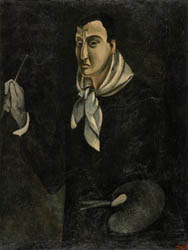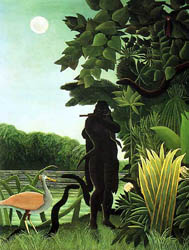|
The turn of the 20th century
ushered in dynamic and fundamental changes for the world of art .
It is generally agreed that the Modern era of art began in the
Realist movement in France during the 1840's. With each successive generation, artists with a
progressive outlook pushed the frontiers of the art world further
away from its academic establishment . However, in the years just prior to
World War I, a counter Modernist movement established itself
in the arts. Expressionism, Cubism and Futurism had each pushed formal
design to an extreme that many people were not yet ready to accept .
The counter movement came to be known as the "Return to Order"
or the "Call or Order", and
can be seen in the work of a many established artists during that time,
especially after the war. For example Andre Derain's quickly
transitioned from Fauvism to Realism influenced by Cezanne. The
"Call to Order" saw other French artists migrate toward traditional
French styles and neoclassicism . In Italy, similar
momentum lead to the formation of Il
Novecento Italiano, which
promoted styles derived from primitive Italian or Roman cultures.
This group was actively promoted by Margherita Sarfatti, who was Mussolini's
mistress. After World War I even Picasso produced work in a classical mode,
especially
from 1920 to 1923. The same can be said for many other artists who
were based
in Paris during this period. Immediately after the war, the public had little
taste for avant-garde art, and its value plummeted for a number of
years. in the
Realist movement in France during the 1840's. With each successive generation, artists with a
progressive outlook pushed the frontiers of the art world further
away from its academic establishment . However, in the years just prior to
World War I, a counter Modernist movement established itself
in the arts. Expressionism, Cubism and Futurism had each pushed formal
design to an extreme that many people were not yet ready to accept .
The counter movement came to be known as the "Return to Order"
or the "Call or Order", and
can be seen in the work of a many established artists during that time,
especially after the war. For example Andre Derain's quickly
transitioned from Fauvism to Realism influenced by Cezanne. The
"Call to Order" saw other French artists migrate toward traditional
French styles and neoclassicism . In Italy, similar
momentum lead to the formation of Il
Novecento Italiano, which
promoted styles derived from primitive Italian or Roman cultures.
This group was actively promoted by Margherita Sarfatti, who was Mussolini's
mistress. After World War I even Picasso produced work in a classical mode,
especially
from 1920 to 1923. The same can be said for many other artists who
were based
in Paris during this period. Immediately after the war, the public had little
taste for avant-garde art, and its value plummeted for a number of
years.
The devastation of World War I brought pervasive disillusionment and
mass disassociation in most European countries, but it took by far
its heaviest toll in the defeated Germany. The initial reaction in
the art world was the nihilistic Dada experiment. Then in the early
twenties many artists began moving away from the emotionally
charged, introspective Expressionism toward realistic
representations. Two types of art initially evolved, as suggested by
Gustav Hartlaub in 1922. On the right, a type of naturalism,
influenced by Classicism and related to Return to Order. On the
left, an incisive, socially critical realism, which produced a
detached and sometimes cynical imagery. Toward the mid 1920s, this
left wing became tempered and moved closer to a more centered
approach .
The artists of the twenties found two important sources of inspiration, both of which helped
them express the feelings of alienation and anxiety that were so
prevalent during these times. These were the "metaphysical" paintings of
Giorgio de Chirico and the naive art of
Henri Rousseau. German
artists adapted the mysterious and dreamlike elements from these
and other predecessors, and combined them with objects from everyday
life. They
endeavored to infuse "magic" into ordinary, even banal
objects. The effect was enhanced by sharply focused realistic style, resulting in
paintings whose details held the viewers interest while also
exploring deep emotional reservoirs .
sources of inspiration, both of which helped
them express the feelings of alienation and anxiety that were so
prevalent during these times. These were the "metaphysical" paintings of
Giorgio de Chirico and the naive art of
Henri Rousseau. German
artists adapted the mysterious and dreamlike elements from these
and other predecessors, and combined them with objects from everyday
life. They
endeavored to infuse "magic" into ordinary, even banal
objects. The effect was enhanced by sharply focused realistic style, resulting in
paintings whose details held the viewers interest while also
exploring deep emotional reservoirs .
In addition to the influences of the artists de Chirico and Rousseau, some of the German
artists of the Neue Sachlichkeit drew stylistic techniques from the art of the
Flemish
and German masters of the 15th and 16th centuries. From these
early models came an art with a highly detailed treatment of subject
matter, with sharp focus in both of the foreground and the
background, and with multiple centers of interest . The were also
able to draw from the Realism of several contemporaries, such as the
French artist, Felix Vallotton .
Our discussion continues....

Neue Sachlichkeit Gallery
European Magic
Realism Gallery
American Magic Realism
Gallery
Chapter 1 - Magic Realism Introduction
Chapter 3 - Neue Sachlichkeit Artists
Chapter 4 - Surrealism vs Magic Realism
Chapter 5 - Magic Realism in other European
countries
Chapter 6 - Magic Realism in the Americas
(1)
Chapter 7 - Magic Realism in the Americas (2)
Chapter 8 - Contemporary Magic Realism
Chapter 9 - The Future of Magic Realism
Email:
dreams@tendreams.org |